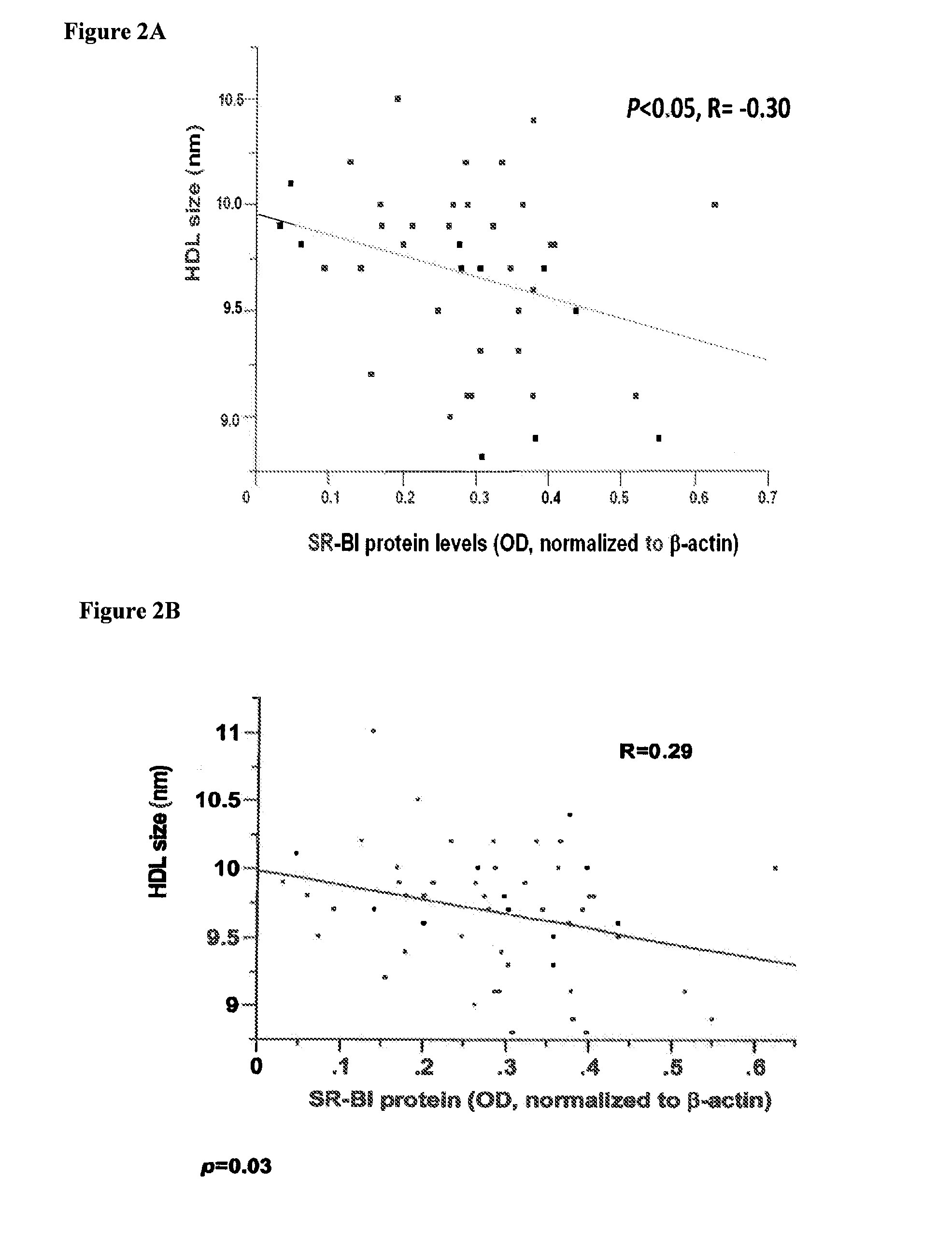Sr-bi as a predictor of elevated high density lipoprotein and cardiovascular disease
a high density lipoprotein and cardiovascular disease technology, applied in the field of single nucleotide polymorphisms, can solve the problems of morbidity and mortality, subject at greater risk of developing elevated levels of high density lipoprotein and cardiovascular diseas
- Summary
- Abstract
- Description
- Claims
- Application Information
AI Technical Summary
Benefits of technology
Problems solved by technology
Method used
Image
Examples
example 1
[0113]The characteristics of the study population are shown in Tables 1A and 1B. The majority of the participants were women, with a mean age of 57.2±10.9 years for this subgroup. Nine women indicated a history of hormone therapy (HT) use, but only three women were current users.
[0114]The primary goal was to determine the relationship between tissue expression of SR-BI protein and HDL-C levels. The rationale for isolating MDMs from each subject was that this tissue is readily accessible—in contrast to other tissues highly expressing SR-BI such as liver, adrenals and gonads—and has been shown to express SR-BI protein. See Rodriguez et al., 100 CIRCULATION SUPPL. 538 (1999); and Hirano et al., 85 CIRC. RES. 108-116 (1999). SR-BI protein levels were found to be normally distributed, whereas SR-BI mRNA levels were not normally distributed (data not shown). As shown in FIG. 1A, in all subjects, SR-BI protein levels were inversely associated with HDL-C levels (p=0.02, r=−0.30, Pearson's c...
example 2
[0118]The relationship between SR-BI protein levels and HDL size as measured by NMR spectroscopy was next determined. As shown in FIG. 2A, in all subjects, HDL particle size was inversely correlated with SR-BI protein level (p=0.03, r=−0.29, n=54). As shown in FIG. 2B, in female subjects, HDL particle size was inversely correlated with SR-BI protein level (p=0.05, r=−0.30, n=42). An association between SR-BI protein levels and VLDL particle number or size, or LDL particle number or size was not observed (data not shown).
example 3
[0119]The uptake of [3H]cholesteryl-oleyl ether mediated by HDL in MDMs isolated from the study subjects was measured. The results in FIG. 3A for male and female subjects showed that the percent CE uptake mediated by HDL was significantly associated with SR-BI protein levels (p=0.01, r=0.38, n=42). The results in FIG. 3B for female subjects showed that the percent CE uptake mediated by HDL was also significantly associated with SR-BI protein levels (p=0.004, r=0.48, n=34).
[0120]It has been shown that a significant inverse relationship between SR-BI protein levels and HDL size, which is in agreement with the findings observed in SR-BI knockout mice. See Rigotti et al., 94 PROC NATL. ACAD. SCI. USA 12610-12615 (1997). The results in FIG. 3A for male and female subjects demonstrated a positive association between SR-BI protein levels and CE uptake from HDL. Such findings are in agreement with data derived from others using in-vitro and animal models that showed the inverse relationship...
PUM
| Property | Measurement | Unit |
|---|---|---|
| Density | aaaaa | aaaaa |
| Biological properties | aaaaa | aaaaa |
Abstract
Description
Claims
Application Information
 Login to View More
Login to View More - R&D
- Intellectual Property
- Life Sciences
- Materials
- Tech Scout
- Unparalleled Data Quality
- Higher Quality Content
- 60% Fewer Hallucinations
Browse by: Latest US Patents, China's latest patents, Technical Efficacy Thesaurus, Application Domain, Technology Topic, Popular Technical Reports.
© 2025 PatSnap. All rights reserved.Legal|Privacy policy|Modern Slavery Act Transparency Statement|Sitemap|About US| Contact US: help@patsnap.com



